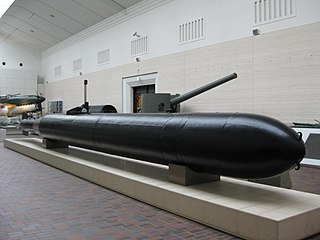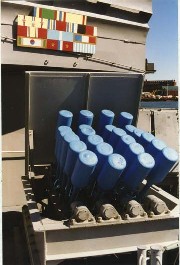
The Battle of the Atlantic, the longest continuous military campaign in World War II, ran from 1939 to the defeat of Nazi Germany in 1945, covering a major part of the naval history of World War II. At its core was the Allied naval blockade of Germany, announced the day after the declaration of war, and Germany's subsequent counter-blockade. The campaign peaked from mid-1940 through to the end of 1943.

A depth charge is an anti-submarine warfare (ASW) weapon. It is intended to destroy a submarine by being dropped into the water nearby and detonating, subjecting the target to a powerful and destructive hydraulic shock. Most depth charges use high explosive charges and a fuze set to detonate the charge, typically at a specific depth. Depth charges can be dropped by ships, patrol aircraft, and helicopters.

USS Thresher (SS-200) was the most decorated United States Navy submarine of World War II, with 15 battle stars and a Navy Unit Commendation. Thresher was the third of twelve Tambor-class submarines that were commissioned. All twelve fought in the war, and she was one of five to survive it.

USS Whale (SS-239), a Gato-class submarine, was the second ship of the United States Navy to be named for a whale, an extremely large, aquatic mammal that is fishlike in form. The USS Cachalot (SS-170) commissioned on 1 December 1933 preceded the Whale.

USS Sailfish (SS-192), was a US Sargo-class submarine, originally named Squalus. As Squalus, the submarine sank off the coast of New Hampshire during test dives on 23 May 1939. The sinking drowned 26 crew members, but an ensuing rescue operation, using the McCann Rescue Chamber for the first time, saved the lives of the remaining 33 aboard. Squalus was salvaged in late 1939 and recommissioned as Sailfish in May 1940.

32°16′N132°05′E

USS Albacore (SS-218) was a Gato-class submarine which served in the Pacific Theater of Operations during World War II, winning the Presidential Unit Citation and nine battle stars for her service. During the war, she was credited with sinking 13 Japanese ships and damaging another five; not all of these credits were confirmed by postwar Joint Army–Navy Assessment Committee (JANAC) accounting. She also holds the distinction of sinking the highest warship tonnage of any U.S. submarine. She was lost in 1944, probably sunk by a mine off northern Hokkaidō on 7 November.

USS Pompano (SS-181), a United States Porpoise-class submarine, was the second ship of the United States Navy to be named for the pompano.

Kaiten were crewed torpedoes and suicide craft, used by the Imperial Japanese Navy in the final stages of World War II.

The Hedgehog was a forward-throwing anti-submarine weapon that was used primarily during the Second World War. The device, which was developed by the Royal Navy, fired up to 24 spigot mortars ahead of a ship when attacking a U-boat. It was deployed on convoy escort warships such as destroyers and corvettes to supplement the depth charges.

Captain Frederic John Walker, was a British Royal Navy officer noted for his exploits during the Second World War. Walker was the most successful anti-submarine warfare commander during the Battle of the Atlantic, and was known popularly as Johnnie Walker.

Squid was a British World War II ship-mounted anti-submarine weapon. It consisted of a three-barrelled mortar which launched depth charges. It replaced the Hedgehog system, and was in turn replaced by the Limbo system.

An anti-submarine weapon (ASW) is any one of a number of devices that are intended to act against a submarine and its crew, to destroy (sink) the vessel or reduce its capability as a weapon of war. In its simplest sense, an anti-submarine weapon is usually a projectile, missile or bomb that is optimized to destroy submarines.

USS Pintado (SS-387/AGSS-387), a Balao-class submarine, was the first ship of the United States Navy to be named for the pintado.

Anti-submarine warfare is a branch of underwater warfare that uses surface warships, aircraft, submarines, or other platforms, to find, track, and deter, damage, or destroy enemy submarines. Such operations are typically carried out to protect friendly shipping and coastal facilities from submarine attacks and to overcome blockades.

I-58 was a Japanese B3 type cruiser submarine that served in the final year of World War II. Her only significant wartime success came with a conventional torpedo attack upon USS Indianapolis on 30 July 1945. She was modified to carry Kaiten manned torpedoes, making several attacks that inflicted minor damage in exchange for every Kaiten launched being sunk. The submarine surrendered in September 1945, and was later scuttled by the United States Navy.

HMS Aylmer was a Captain-class frigate of the Royal Navy that served during World War II. The ship was named after Matthew Aylmer, commander of HMS Royal Katherine at the Battle of Barfleur in 1692 during the War of the Grand Alliance.
The creeping attack was an anti submarine measure developed during the Battle of the Atlantic in World War II.

United States Navy operations during World War I began on April 6, 1917, after the formal declaration of war on the German Empire. The American navy focused on countering enemy U-boats in the Atlantic Ocean and the Mediterranean Sea while convoying men and supplies to France and Italy. Because of United States's late entry into the war, her capital ships never engaged the German fleet and few decisive submarine actions occurred.
The Western Approaches Tactical Unit (WATU) was a unit of the British Royal Navy created in January 1942 to develop and disseminate new tactics to counter German submarine attacks on trans-Atlantic shipping convoys. It was led by Captain Gilbert Roberts and was principally staffed by officers and ratings from the Women's Royal Naval Service (Wrens). Their primary tool for studying U-boat attacks and developing countermeasures was wargames. After the U-boat threat to merchant shipping was defeated, WATU continued to develop anti-submarine tactics for later stages of the war, including Operation Overlord and the Pacific War. WATU trained naval officers in its tactics by hosting week-long training courses in which the students played wargames. WATU formally ceased operations at the end of July 1945.